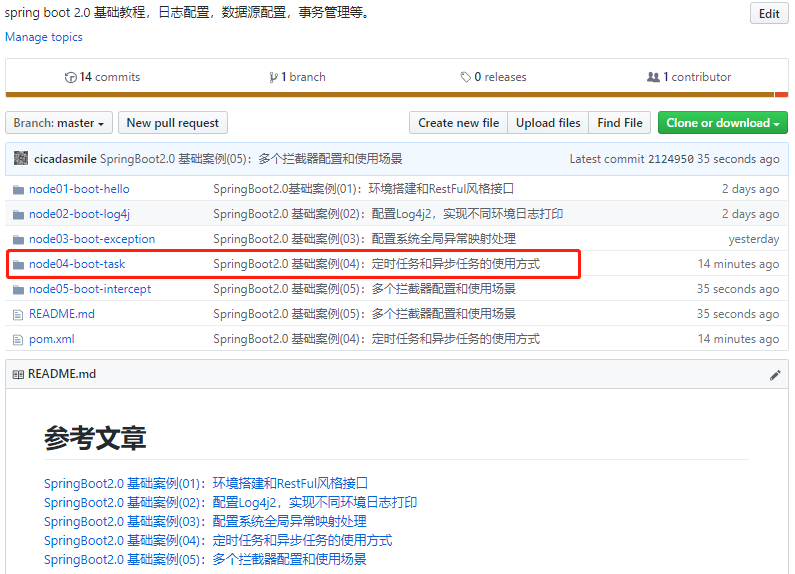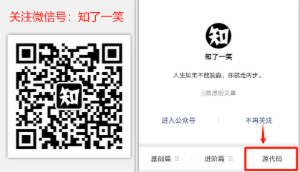SpringBoot2.0 基础案例(04):定时任务和异步任务的使用方式
一、定时任务
1、基本概念
按照指定时间执行的程序。
2、使用场景
数据分析 数据清理 系统服务监控
二、同步和异步
1、基本概念
同步调用
程序按照代码顺序依次执行,每一行程序都必须等待上一行程序执行完成之后才能执行;
异步调用
顺序执行时,不等待异步调用的代码块返回结果就执行后面的程序。
2、使用场景
短信通知 邮件发送 批量数据入缓存
三、SpringBoot2.0使用定时器
1、定时器执行规则注解
@Scheduled(fixedRate = 5000) :上一次开始执行时间点之后5秒再执行 @Scheduled(fixedDelay = 5000) :上一次执行完毕时间点之后5秒再执行 @Scheduled(initialDelay=1000, fixedRate=5000) :第一次延迟1秒后执行,之后按fixedRate的规则每5秒执行一次 @Scheduled(cron="/5") :通过cron表达式定义规则
2、定义时间打印定时器
import org.slf4j.Logger;
import org.slf4j.LoggerFactory;
import org.springframework.scheduling.annotation.Scheduled;
import org.springframework.stereotype.Component;
import java.text.SimpleDateFormat;
import java.util.Date;
/**
* 时间定时任务
*/
@Component
public class TimeTask {
Logger LOG = LoggerFactory.getLogger(TimeTask.class.getName()) ;
private static final SimpleDateFormat format =
new SimpleDateFormat("yyyy-MM-dd HH:mm:ss") ;
/**
* 每3秒打印一次系统时间
*/
@Scheduled(fixedDelay = 3000)
public void systemDate (){
LOG.info("当前时间::::"+format.format(new Date()));
}
}
3、启动类开启定时器注解
@EnableScheduling // 启用定时任务
@SpringBootApplication
public class TaskApplication {
public static void main(String[] args) {
SpringApplication.run(TaskApplication.class,args) ;
}
}
四、SpringBoot2.0使用异步任务
1、编写异步任务类
import org.slf4j.Logger;
import org.slf4j.LoggerFactory;
import org.springframework.scheduling.annotation.Async;
import org.springframework.stereotype.Component;
@Component
public class AsyncTask {
private static final Logger LOGGER = LoggerFactory.getLogger(AsyncTask.class) ;
/*
* [ asyncTask1-2] com.boot.task.config.AsyncTask : ======异步任务结束1======
* [ asyncTask1-1] com.boot.task.config.AsyncTask : ======异步任务结束0======
*/
// 只配置了一个 asyncExecutor1 不指定也会默认使用
@Async
public void asyncTask0 () {
try{
Thread.sleep(5000);
}catch (Exception e){
e.printStackTrace();
}
LOGGER.info("======异步任务结束0======");
}
@Async("asyncExecutor1")
public void asyncTask1 () {
try{
Thread.sleep(5000);
}catch (Exception e){
e.printStackTrace();
}
LOGGER.info("======异步任务结束1======");
}
}
2、指定异步任务执行的线程池
这里可以不指定,指定执行的线城池,可以更加方便的监控和管理异步任务的执行。
import org.springframework.context.annotation.Bean;
import org.springframework.context.annotation.Configuration;
import org.springframework.scheduling.concurrent.ThreadPoolTaskExecutor;
import java.util.concurrent.Executor;
import java.util.concurrent.ThreadPoolExecutor;
/**
* 定义异步任务执行的线程池
*/
@Configuration
public class TaskPoolConfig {
@Bean("asyncExecutor1")
public Executor taskExecutor1 () {
ThreadPoolTaskExecutor executor = new ThreadPoolTaskExecutor();
// 核心线程数10:线程池创建时候初始化的线程数
executor.setCorePoolSize(10);
// 最大线程数20:线程池最大的线程数,只有在缓冲队列满了之后才会申请超过核心线程数的线程
executor.setMaxPoolSize(20);
// 缓冲队列200:用来缓冲执行任务的队列
executor.setQueueCapacity(200);
// 允许线程的空闲时间60秒:当超过了核心线程出之外的线程在空闲时间到达之后会被销毁
executor.setKeepAliveSeconds(60);
// 线程池名的前缀:设置好了之后可以方便定位处理任务所在的线程池
executor.setThreadNamePrefix("asyncTask1-");
/*
线程池对拒绝任务的处理策略:这里采用了CallerRunsPolicy策略,
当线程池没有处理能力的时候,该策略会直接在 execute 方法的调用线程中运行被拒绝的任务;
如果执行程序已关闭,则会丢弃该任务
*/
executor.setRejectedExecutionHandler(new ThreadPoolExecutor.CallerRunsPolicy());
// 设置线程池关闭的时候等待所有任务都完成再继续销毁其他的Bean
executor.setWaitForTasksToCompleteOnShutdown(true);
// 设置线程池中任务的等待时间,如果超过这个时候还没有销毁就强制销毁,以确保应用最后能够被关闭,而不是阻塞住。
executor.setAwaitTerminationSeconds(600);
return executor;
}
}
3、启动类添加异步注解
@EnableAsync // 启用异步任务
@SpringBootApplication
public class TaskApplication {
public static void main(String[] args) {
SpringApplication.run(TaskApplication.class,args) ;
}
}
4、异步调用的测试接口
@RestController
public class TaskController {
@Resource
private AsyncTask asyncTask ;
@RequestMapping("/asyncTask")
public String asyncTask (){
asyncTask.asyncTask0();
asyncTask.asyncTask1();
return "success" ;
}
}
五、源代码地址
GitHub地址:知了一笑 https://github.com/cicadasmile/spring-boot-base 码云地址:知了一笑 https://gitee.com/cicadasmile/spring-boot-base


正文到此结束
热门推荐
相关文章
Loading...











![[HBLOG]公众号](https://www.liuhaihua.cn/img/qrcode_gzh.jpg)

